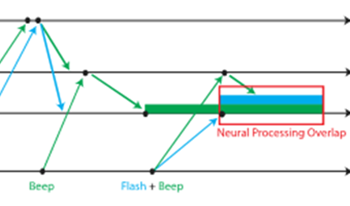References
1AlaisD.BurrD.2003The ‘flash-lag’ effect occurs in audition and cross-modallyCurr. Biol.13596359–6310.1016/S0960-9822(02)01402-1
2ArstilaV.2015Keeping postdiction simpleConscious. Cogn.38205216205–1610.1016/j.concog.2015.10.001
3BachmannT.2013Neurobiological mechanisms behind the spatiotemporal illusions of awareness used for advocating prediction or postdictionFrontiers Psychol.359310.3389/fpsyg.2012.00593
4BeauchampM. S.ArgallB.BodurkaJ.DuynJ.MartinA.2004Unraveling multisensory integration: Patchy organization within human STS multisensory cortexNat. Neurosci.7119011921190–210.1038/nn1333
5BergerC. C.Gonzalez-FrancoM.2018Expanding the sense of touch outside the bodyProc. 15th ACM Symposium on Applied PerceptionAssociation for Computing MachineryVancouver, BC, Canada
6BinettiN.ChengT.MareschalI.BrumbyD.JulierS.Bianchi-BerthouzeN.2019Assumptions about the positioning of virtual stimuli affect gaze direction estimates during Augmented Reality based interactionsSci. Rep.9256610.1038/s41598-019-39311-1
7CarterO.KonkleT.WangQ.HaywardV.MooreC.2008Tactile rivalry demonstrated with an ambiguous apparent-motion quartetCurr. Biol.18105010541050–410.1016/j.cub.2008.06.027
8ChenY.-C.SpenceC.2011The crossmodal facilitation of visual object representations by sound: Evidence from the backward masking paradigmJ. Exp. Psychol. Hum. Percept. Perform.37178410.1037/a0025638
9ChoiH.SchollB. J.2006Perceiving causality after the fact: Postdiction in the temporal dynamics of causal perceptionPerception35385399385–9910.1068/p5462
10EaglemanD. M.SejnowskiT. J.2000Motion integration and postdiction in visual awarenessScience287203620382036–810.1126/science.287.5460.2036
11EaglemanD. M.SejnowskiT. J.2003The line-motion illusion can be reversed by motion signals after the line disappearsPerception32963968963–810.1068/p3314a
12EastonR. D.GreeneA. J.SrinivasK.1997Transfer between vision and haptics: Memory for 2-D patterns and 3-D objectsPsychonomic Bull. Rev.4403410403–1010.3758/BF03210801
13FreemanE.DriverJ.2008Direction of visual apparent motion driven solely by timing of a static soundCurr. Biol.18126212661262–610.1016/j.cub.2008.07.066
14GeldardF. A.SherrickC. E.1972The cutaneous ‘rabbit’: A perceptual illusionScience178178179178–910.1126/science.178.4057.178
15GeldardF. A.1976The saltatory effect in visionSens Processes.1778677–86
16GetzmannS.2007The effect of brief auditory stimuli on visual apparent motionPerception36108911031089–10310.1068/p5741
17GoldreichD.TongJ.2013Prediction, postdiction, and perceptual length contraction: A Bayesian low-speed prior captures the cutaneous rabbit and related illusionsFrontiers Psychol.422110.3389/fpsyg.2013.00221
18Gonzalez-FrancoM.BergerC. C.2019Avatar embodiment enhances haptic confidence on the out-of-body touch illusionIEEE Trans. Haptics12319326319–2610.1109/TOH.2019.2925038
19GoodaleM. A.MilnerA. D.1992Separate visual pathways for perception and actionTrends Neurosci.15202520–510.1016/0166-2236(92)90344-8
20von GrünauM. W.1986A motion aftereffect for long-range stroboscopic apparent motionPercept. Psychophys.40313831–810.3758/BF03207591
21HarrarV.WinterR.HarrisL. R.2008Visuotactile apparent motionPercept. Psychophys.70807817807–1710.3758/PP.70.5.807
22HerzogM. H.Drissi-DaoudiL.DoerigA.
23KaiserM.SenkowskiD.BuschN. A.BalzJ.KeilJ.2019Single trial prestimulus oscillations predict perception of the sound-induced flash illusionSci. Rep.9181–8
24KawabeT.2011Nonretinotopic processing is related to postdictive size modulation in apparent motionAtten. Percept. Psychophys.73152215311522–3110.3758/s13414-011-0128-4
25KolersP. A.von GrünauM.1976Shape and color in apparent motionVis. Res.16329335329–3510.1016/0042-6989(76)90192-9
26KeilJ.2020Double flash illusions: Current findings and future directionsFrontiers Neurosci.1429810.3389/fnins.2020.00298
27LakatosS.ShepardR. N.1997Constraints common to apparent motion in visual, tactile, and auditory spaceJ. Exp. Psychol.: Hum. Percept. Perform.23105010.1037/0096-1523.23.4.1050
28LiaciE.BachM.Tebartz van ElstL.HeinrichS. P.KornmeierJ.2016Ambiguity in tactile apparent motion perceptionPLoS ONE11e015273610.1371/journal.pone.0152736
29LibetB.Mind Time: The Temporal Factor in Consciousness2009Harvard University PressCambridge, MA
30LiuY.StilesN. R. B.MeisterM.2018Augmented reality powers a cognitive assistant for the blindeLife7e3784110.7554/eLife.37841
31MackayD. M.1958Perceptual stability of a stroboscopically lit visual field containing self-luminous objectsNature181507508507–810.1038/181507a0
32MarchantJ. L.RuffC. C.DriverJ.2012Audiovisual synchrony enhances BOLD responses in a brain network including multisensory STS while also enhancing target-detection performance for both modalitiesHuman Brain Mapping33121212241212–2410.1002/hbm.21278
33MishraJ.MartinezA.SejnowskiT. J.HillyardS. A.2007Early cross-modal interactions in auditory and visual cortex underlie a sound-induced visual illusionJ. Neurosci.27412041314120–3110.1523/JNEUROSCI.4912-06.2007
34MiyazakiM.HirashimaM.NozakiD.2010The ‘Cutaneous Rabbit’ hopping out of the bodyJ. Neurosci.30185618601856–6010.1523/JNEUROSCI.3887-09.2010
35MuckliL.KohlerA.KriegeskorteN.SingerW.2005Primary visual cortex activity along the apparent-motion trace reflects illusory perceptionPLoS Biol.3e26510.1371/journal.pbio.0030265
36NijhawanR.1994Motion extrapolation in catchingNature370256257256–710.1038/370256b0
37NijhawanR.KirschfeldK.2003Analogous mechanisms compensate for neural delays in the sensory and the motor pathways: Evidence from motor flash-lagCurr. Biol.13749753749–5310.1016/S0960-9822(03)00248-3
38Pascual-LeoneA.HamiltonR.2001The metamodal organization of the brainProgress Brain Res.134427445427–45
39RaabD. H.1963Backward maskingPsychol. Bull.6011810.1037/h0040543
40RamachandranV. S.AnstisS. M.1986The perception of apparent motionSci. Am.254102109102–910.1038/scientificamerican0686-102
41RutschmannJ.LinkR.1964Perception of temporal order of stimuli differing in sense mode and simple reaction timePerceptual and Motor Skills18345352345–5210.2466/pms.1964.18.2.345
42SanabriaD.Soto-FaracoS.SpenceC.2005Assessing the effect of visual and tactile distractors on the perception of auditory apparent motionExp. Brain Res.166548558548–5810.1007/s00221-005-2395-6
43SchacterD. L.BucknerR. L.1998Priming and the brainNeuron20185195185–9510.1016/S0896-6273(00)80448-1
44ShamsL.KamitaniY.ShimojoS.2000What you see is what you hearNature40878810.1038/35048669
45ShamsL.KamitaniY.ThompsonS.ShimojoS.2001Sound alters visual evoked potentials in humansNeuroreport12384938523849–5210.1097/00001756-200112040-00049
46ShimojoS.SimionC.ShimojoE.ScheierC.2003Gaze bias both reflects and influences preferenceNat. Neurosci.6131713221317–2210.1038/nn1150
47ShimojoS.2014Postdiction: Its implications on visual awareness, hindsight, and sense of agencyFrontiers Psychol.519610.3389/fpsyg.2014.00196
48ShimojoS.MiyauchiS.HikosakaO.1997Visual motion sensation yielded by non-visually driven attentionVis. Res.37157515801575–8010.1016/S0042-6989(96)00313-6
49ShoreD. I.HallS. E.KleinR. M.1998Auditory saltation: A new measure for an old illusionJ. Acoust. Soc. Am.103373037333730–310.1121/1.423093
50Soto-FaracoS.SpenceC.KingstoneA.2004Cross-modal dynamic capture: Congruency effects in the perception of motion across sensory modalitiesJ. Exp. Psychol.: Hum. Percept. Perform.3033010.1037/0096-1523.30.2.330
51StilesN. R. B.LiM.LevitanC. A.KamitaniY.ShimojoS.2018What you saw is what you will hear: Two new illusions with audiovisual postdictive effectsPLoS ONE13e020421710.1371/journal.pone.0204217
52StrybelT. Z.ManligasC. L.ChanO.PerrottD. R.1990A comparison of the effects of spatial separation on apparent motion in the auditory and visual modalitiesPercept. Psychophys.47439448439–4810.3758/BF03208177
53SunL.FrankS. M.HartsteinK. C.HassanW.TseP. U.2017Back from the future: Volitional postdiction of perceived apparent motion directionVis. Res.140133139133–910.1016/j.visres.2017.09.001
54TanguayA. R.Jr.StilesN. R. B.GangulyI.ShimojoS.2019Time dependence of predictive and postdictive auditory–visual processing: The temporally extended audiovisual rabbit illusionJ. Vis.1919b
55TanguayA. R.Jr.StilesN. R. B.GangulyI.ShimojoS.2020Mapping audio-visual crossmodal interactions in the visually impairedJ. Vis.20176810.1167/jov.20.11.1768
56VroomenJ.de GelderB.2004Temporal ventriloquism: Sound modulates the flash-lag effectJ. Exp. Psychol.: Hum. Percept. Perform.3051310.1037/0096-1523.30.3.513
57YamadaY.KawabeT.MiyazakiM.2015Awareness shaping or shaped by prediction and postdictionFrontiers Psychol.616610.3389/fpsyg.2015.00166

 Find this author on Google Scholar
Find this author on Google Scholar Find this author on PubMed
Find this author on PubMed